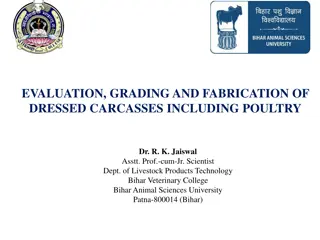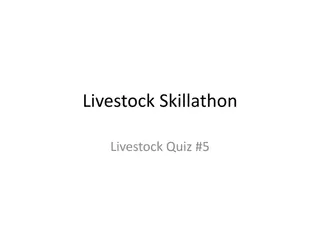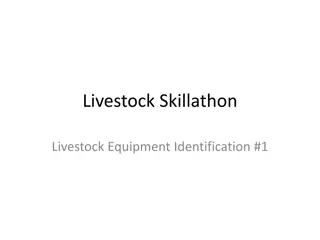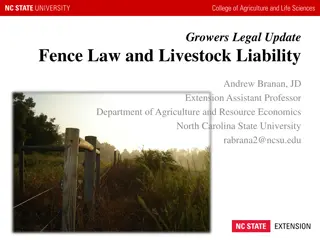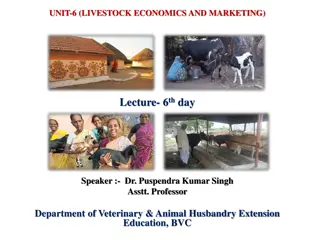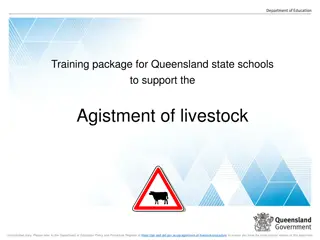Understanding Livestock Economics: The Law of Supply Explained
Exploring the concept of supply in livestock economics, this lecture covers theories, individual supply schedules, market supply schedules, and the law of supply. Dr. Puspendra Kumar Singh delves into the relationship between commodity prices and producer supply, offering insights into market dynamics and supply curve analysis.
Download Presentation

Please find below an Image/Link to download the presentation.
The content on the website is provided AS IS for your information and personal use only. It may not be sold, licensed, or shared on other websites without obtaining consent from the author. Download presentation by click this link. If you encounter any issues during the download, it is possible that the publisher has removed the file from their server.
E N D
Presentation Transcript
UNIT-6 (LIVESTOCK ECONOMICS AND MARKETING) Lecture- 4thday Speaker :- Dr. Puspendra Kumar Singh Asstt. Professor Department of Veterinary & Animal Husbandry Extension Education, BVC
Topics covered Theories of supply and cost.
SUPPLY Various amounts of commodities, which the producers are willing and able to make available for sale at various prices during a given time
STOCK Stock is the amount of output that exists in a market. Depending on the demand for a commodity stock is converted into supply.
INDIVIDUAL SUPPLY SCHEDULE Supply schedule depicts the list of quantities- price relationships of a commodity in a market at a specific point of time by an individual seller
Hypothetical Supply Schedule of a Commodity in a Market Price (Rs./Q.) Quantity supplied (Q.) 300 325 350 375 400 425 30 40 50 60 70 80
Supply curve S y Price S 0 x Quantity
Market Supply It is the sum of the quantity of commodity that is brought into a market for sale by the sellers in a given market at a specific point of time
Market Supply Schedule Price (Rs./Q.) Individual sellers supply /week (Q.) Market supply (Q.) A+B+C A 30 40 50 60 70 80 B 35 50 65 80 95 110 C 0 0 50 70 90 110 300 325 350 375 400 425 65 90 165 210 255 300
Market Supply curve Sm y Price Sm 0 x Quantity supplied
LAW OF SUPPLY The law signifies the positive relationship i.e. as the price of a commodity rises its supply extends and as the price falls its supply contracts, with other things remaining the same
Extension & contraction of supply (Change in quantity supplied) Extension of supply means offering more quantity for sale at a higher price, while contraction means offering less quantity at a lower price.
Extension & contraction of supply S y B P1 A Price P S 0 x Q1 Q Quantity supplied
Increase & Decrease in Supply (Shift in supply) Increase in supply implies more supply at the same price and decrease in supply means less supply at the same price.
Increase & decrease of supply S2 S y S1 P Price S2 S S1 0 x Q2 Q Q1 Quantity supplied
Factors causing changes in supply (shift factor) Changes in technology Reduction in resource prices Reduction in the relative prices of other products Market infrastructure Number of producers Producers expectations about future prices
ELASTICITY OF SUPPLY Elasticity of supply of a commodity is the responsiveness, or sensitiveness of supply to the changes in price. Elasticity of supply (Es) = % change in quantity of good supplied % change in price of good supplied
Illustration Suppose the price of an egg rises from Rs. 1 to Rs. 2 and as a result the supply increases from 10 to 30 eggs Es= 2 Means 1 percent increase in price, there is 2 percent increase in quantity supplied.
Degrees of elasticity of supply Perfectly Elastic Supply Perfectly Inelastic Supply Relatively Elastic Supply Relatively Inelastic Supply Unitary Elastic Supply
Perfectly Elastic Supply When the supply of commodity increases to infinite quantity or unlimited quantity, even though there is invisible rise or minute rise in the price, the elasticity of supply is said to be infinity.
Perfectly Elastic Supply y Price S S 0 x Quantity
Perfectly Inelastic Supply It means that the quantity supplied is not responsive to change in prices. Elasticity of supply in this case is zero.
Perfectly Inelastic Supply S y Price S 0 x Quantity
Relatively Elastic Supply Supply is referred as relatively elastic, when the percentage change in quantity supplied is more than the corresponding percentage change in price. It is also called elastic supply. Elasticity of supply is more than one.
Relatively Elastic Supply S y P1 Price P S 0 x Q1 Q Quantity
Relatively Inelastic Supply Supply is said to be relatively inelastic, when the percentage change in quantity supplied is less than the corresponding percentage change in price. In this case the elasticity of supply is less than one.
Relatively Inelastic Supply S y P1 Price P S 0 x Q1 Q Quantity
Unitary Elastic Supply When percentage change in quantity supplied equals the percentage change in price, it is called unitary elastic supply. Here the elasticity of supply is equal to one.
Unitary Elastic Supply S y P1 Price P S 0 x Q1 Q Quantity
Factors influencing Elasticity of Supply Availability of inputs of Production Length of Time Period Diversification of Production Activity Availability of Alternative Markets Flexibility in Starting and Winding up the Business



